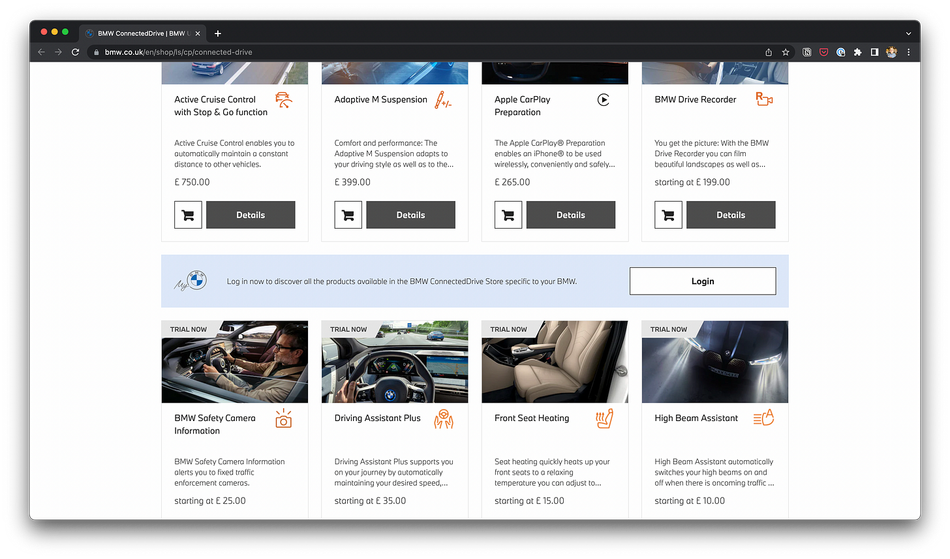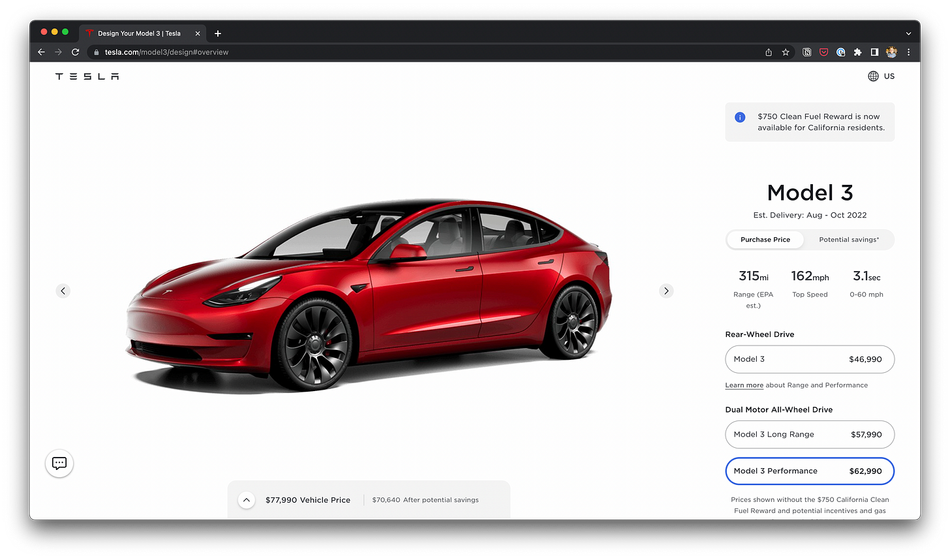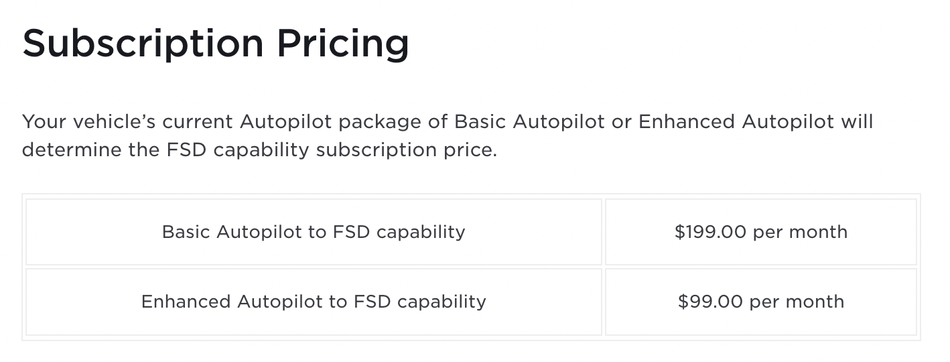The Wrong Way to Add Subscriptions
BMW's attempt to enter the world of subscription services.
This is the second piece in a 4-part opinion series for and about hardware/software businesses.
Last week, the media picked up that BMW is selling heated seat subscriptions for $18/month in some countries. As a result, BMW is awash in negative press, garnering headlines such as “BMW Has Started Charging by the Month to Keep Your Ass Warm” and “The future of cars is a subscription nightmare”.
Internally, Particle had… similar feelings. Some choice quotes from our Slack thread on the topic:
“Would 100% ensure I didn't buy a BMW”
“Very excited to live in the new microtransaction hellscape.”
“Reminds me of Spirit Airlines ‘racing towards’ charging for carry-ons.”
“I hate this with every fiber of my being”
But wait a second. Particle is an IoT platform whose customers ship hardware/software products, generally with subscriptions attached. This newsletter is only on its fourth issue and I’ve already advocated for “hardware-as-a-service” business models at least twice. So why all the shade cast towards BMW?
I believe that manufacturing businesses are going through a business model transformation that will lead to any high-value product ($10K+) being sold either partially or completely under a subscription model. Businesses that drive that transformation will become industry leaders, and others will be left behind.
But I also believe there is a right way and a wrong way to go through that transformation. And BMW’s approach is, frankly, wrong.
So, let’s use this as a case study. What is the wrong way to implement subscriptions for a hardware product? And what does that imply about what the right way is?
BMW’s Subscription Model
First, let’s get past the headlines and lay out the facts about BMW’s subscription model:
In 2020, BMW announced that they would begin selling features of its cars through “digital after-sales”. Here’s the relevant text from the announcement:
BMW already offers its customers digital services and additional vehicle functions in the form of digital after-sales, some of which are deeply embedded in the vehicle's software. In the US, BMW Drive Recorder is offered through a pilot program. In the near future, additional functions will be added that can access the vehicle's existing hardware and software, such as certain comfort functions or driver assistance systems.
With the option of subsequently booking additional vehicle functions via the ConnectedDrive Store, BMW is strengthening selection and personalization for customers, offering them maximum flexibility. BMW provides the hardware and software in the vehicle at the time of manufacture for the implementation so that it can be adapted later on as required and in accordance with customer preferences. If, for example, vehicle functions were not yet requested at the time of purchase, they can be added later. A second owner thus can configure the used vehicle according to their own wishes.
Side note: I find it fascinating that they seem to be avoiding the word “purchase”, like they don’t want to admit that you’re going to have to pay for this stuff. You can “book” additional vehicle functions, they can be “added later”. Look folks, if you’re embarrassed to admit your own business model, you’re probably doing it wrong.
As promised, the BMW ConnectedDrive is filled with “digital services” you can buy (sorry, “add”). As of July 19, 2022, you can “add” a total of 13 features:
Active Cruise Control with Stop & Go function (Purchase)
Adaptive M Suspension (Purchase)
Apple CarPlay Preparation (Purchase)
BMW Drive Recorder (Purchase)
BMW Safety Camera Information (Subscription)
Driving Assistant Plus (Subscription)
Front Seat Heating (Subscription)
High Beam Assistant (Subscription)
IconicSounds Sport (Purchase)
Map Update Package (Purchase)
Online Entertainment Voucher (Subscription)
Service Inclusive (Warranty-style purchase, limited to 5yrs/100K km)
Steering Wheel Heating (Subscription)

Putting aside “Service Inclusive”, which seems like a standard AppleCare+ style model of expanding and extending the warranty, six of these upgrades are one-time purchases and six of these upgrades are subscriptions.
If you’re like me, you’re probably reacting to this list as follows:
It seems reasonable to charge a one-time fee for upgrades that I would traditionally purchase as part of a premium trim package (like “Adaptive M Suspension”). Rather than buying a basket of features up front when I buy the car, I can select only what I want and buy it whenever I feel like it. I’m good with that.
That said, the longer this list gets, the more I feel like I’m being nickeled-and-dimed. “Bundling” does have a clear benefit to the customer: avoiding “microtransaction hell”.
I kinda love that you can pay 99 euros to play the BMW engine sound inside the vehicle. That sort of reminds me of buying ringtones circa 2004.
Once we hit the subscriptions, things go off the rails. The seat heaters are the feature getting all the flack, but “high beam assistant” and “steering wheel heating” feel equally wrong.
This subjective, intuitive reaction to the list of 13 features that BMW offers as “digital after-sales” shows that some fee structures seem reasonable and others don’t. As we build a framework for the right and wrong ways to add subscriptions to a hardware product, let’s pull in a counter-example from the automotive world – Tesla’s Autopilot.
Tesla Autopilot
If I go onto Tesla’s website to buy a Model 3, I am presented with a slick user interface to customize by car by adding/removing features. At the moment, I can spend as little as $46,990 or as much as $77,990 on a Model 3.

That $77,990 price at the top end includes a whopping $12,000 for “Full Self-Driving Capability”. Tesla has gotten a lot of shit for how they’ve marketed this feature by overpromising and under-delivering on delivering a true “self-driving car”, but to give credit where it’s due, if you put aside the cost and the marketing for a second, this feature is pretty damn nice. Tesla has been a market leader in driver assistance features since it originally launched Autopilot in October 2015, even if other automotive manufacturers have since caught up.
But Tesla didn’t just lead the pack on driver assistance tech. They also innovated on the business model. Because if I choose not to pay $12K for the feature up front, I can choose to activate a “Full Self-Driving Capability Subscription” later.

There is something inherently less icky about Tesla’s subscription model here. There are some major differences between BMW and Tesla’s subscription models that influence how customers will react to them:
Tesla offers one subscription instead of many.
Tesla’s subscription makes a very expensive feature more accessible.
Tesla emphasizes the ability to unsubscribe at any time and thus only pay for FSD when you’re actively using it.
Tesla uses its subscription to facilitate evaluation; customers who are unsure whether they’d like FSD can sign up for a month and try it out. This is important because a) most people haven’t tried one of these driver assistance systems when they buy a Tesla so they might be unsure of whether they’ll like it, and b) the feature keeps improving so if you try it and don’t like it you can give it another shot after a year or two of improvements.
And now the big one: Tesla’s subscription is applied to a feature whose value is delivered through software rather than through hardware.
This last bullet is, in my opinion, the most important one.
As the electronics products that we own have become more intelligent, we’ve become trained to separate “hardware value” from “software value”. We attribute features that rely heavily on physical characteristics of the product – like heated seats – to hardware value that we expect to purchase upfront. In contrast, we understand that some features require a heavier software investment; those features have user interfaces presented on screens and get downloaded over-the-air and are improved over time by the manufacturer. We understand that these features require an ongoing cost to deliver, and therefore we are more willing to entertain the idea that the manufacturer has earned an ongoing fee.
A Better Subscription Model for BMW
Given the nature of the features that BMW is attempting to provide via subscription, is there a different model they could pursue that wouldn’t piss people off?
Yes! At least I think so. If I were BMW, I would bundle the relevant features into a “Winter Driving Package” that would look something like this:
Heated seats
Heated steering wheel
Remote engine start, windshield defrost, and climate control (heat up the car and notify you via push notification when it’s nice and cozy inside)
Advanced driving features to facilitate safer driving on ice and in snow (look, I don’t know what these features would be exactly, but I’m sure the smart people at BMW could figure it out)
$49/mo subscription, activate/deactivate at any time (encouraging customers to activate for the winter and deactivate in the spring when the weather warms up)
Marketing campaigns in the fall to sell a discounted “full season” winter driving package (e.g. $249 for access to the Winter Driving Package from October 1 to April 31)
Why does this feel better than BMW’s current approach? Because it’s using a subscription model to do something that provides an actual benefit to customers. Not everybody lives in a climate that requires a winter driving package, not everyone is willing to pay for these features, and nobody needs them at all during the summer. If we design subscription packages around how customers want to use our products, we can build subscription revenue in ways that make customers happy.
